Business and Business Environment
VerifiedAdded on 2022/12/27
|16
|5442
|1
AI Summary
This document explores the different types and purposes of organizations, the inter-relationship of various functions within organizations, and the impact of macro environment on business operations. It provides insights into business structures and interrelations of organization functions.
Contribute Materials
Your contribution can guide someone’s learning journey. Share your
documents today.
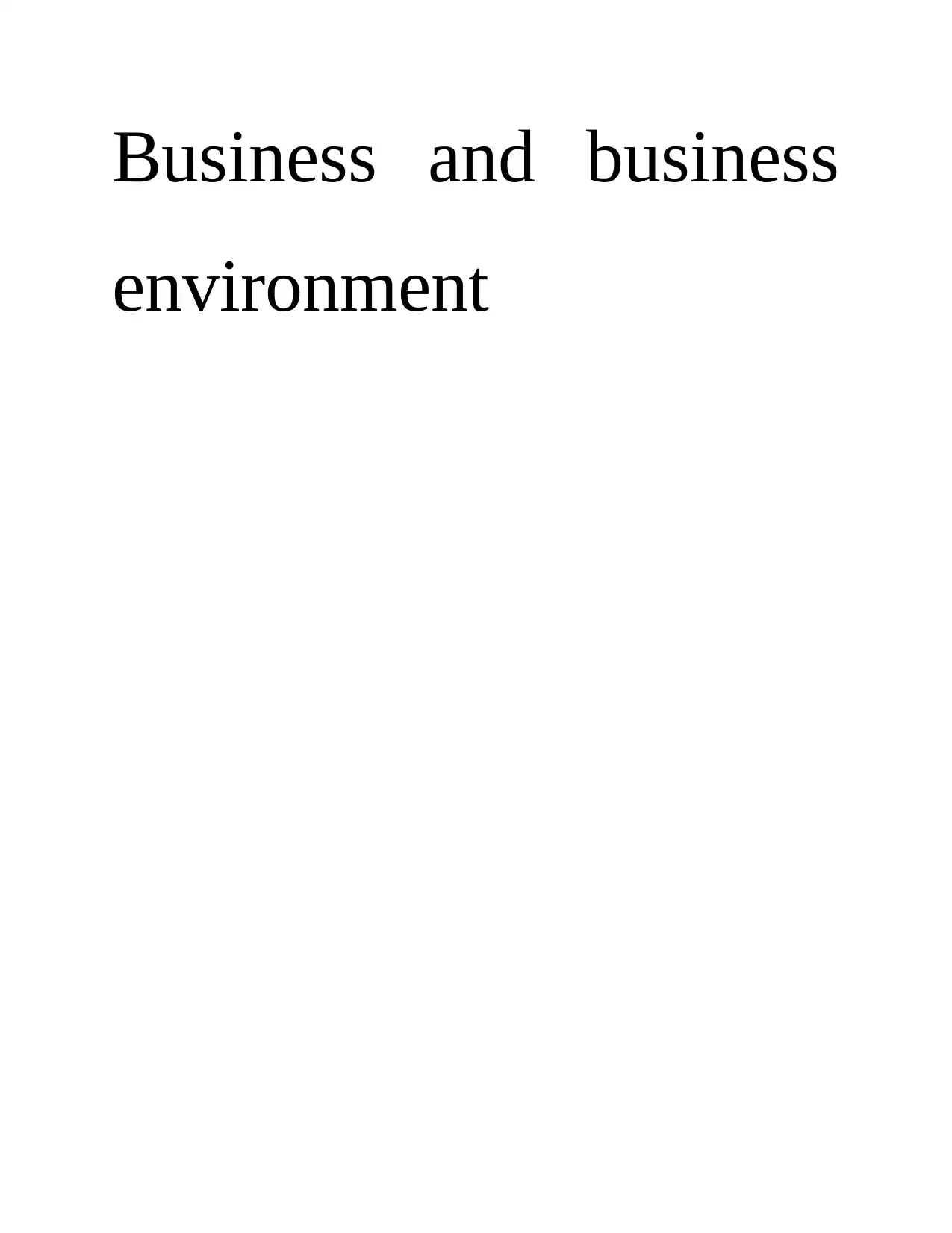
Business and business
environment
environment
Secure Best Marks with AI Grader
Need help grading? Try our AI Grader for instant feedback on your assignments.
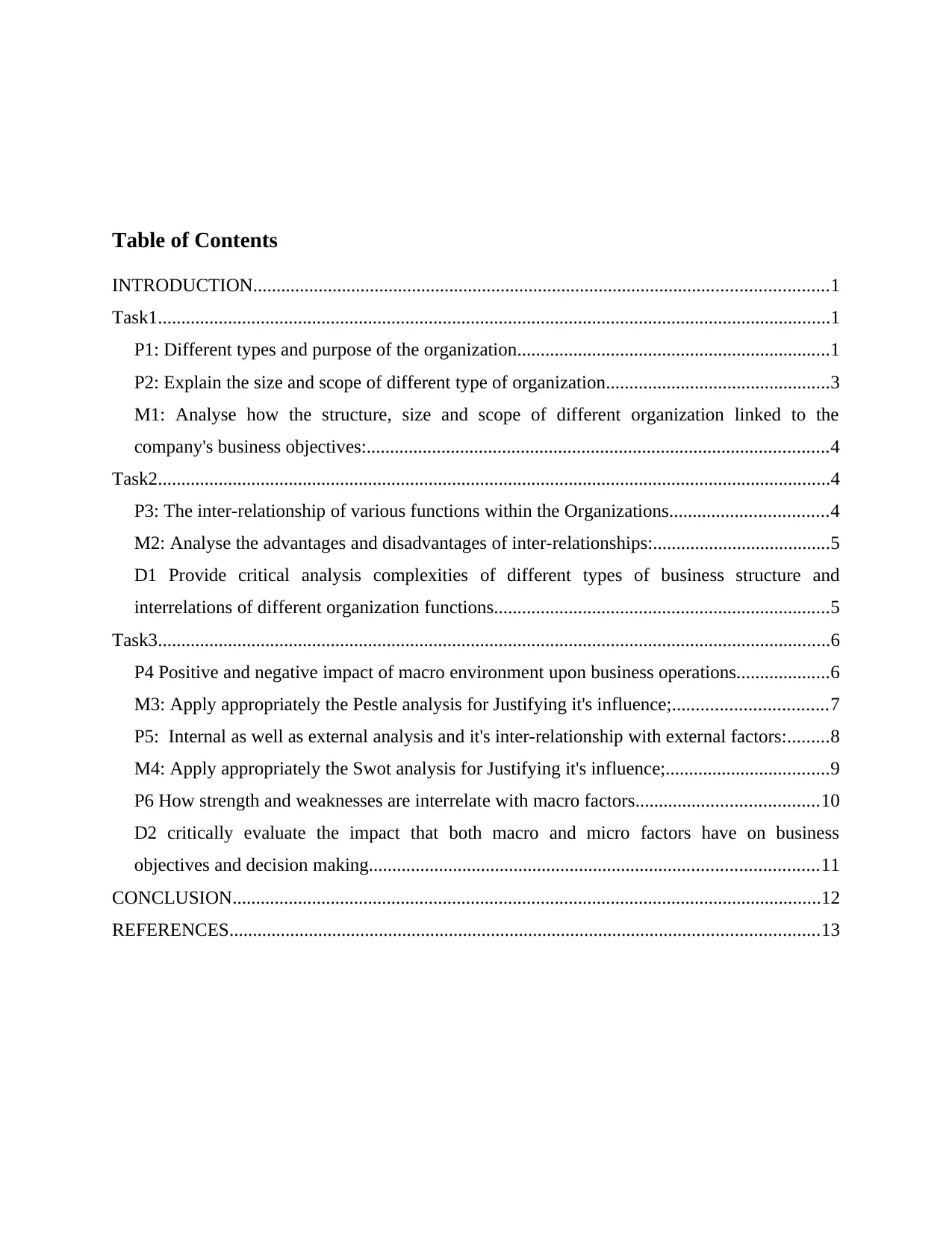
Table of Contents
INTRODUCTION...........................................................................................................................1
Task1................................................................................................................................................1
P1: Different types and purpose of the organization...................................................................1
P2: Explain the size and scope of different type of organization................................................3
M1: Analyse how the structure, size and scope of different organization linked to the
company's business objectives:...................................................................................................4
Task2................................................................................................................................................4
P3: The inter-relationship of various functions within the Organizations..................................4
M2: Analyse the advantages and disadvantages of inter-relationships:......................................5
D1 Provide critical analysis complexities of different types of business structure and
interrelations of different organization functions........................................................................5
Task3................................................................................................................................................6
P4 Positive and negative impact of macro environment upon business operations....................6
M3: Apply appropriately the Pestle analysis for Justifying it's influence;.................................7
P5: Internal as well as external analysis and it's inter-relationship with external factors:.........8
M4: Apply appropriately the Swot analysis for Justifying it's influence;...................................9
P6 How strength and weaknesses are interrelate with macro factors.......................................10
D2 critically evaluate the impact that both macro and micro factors have on business
objectives and decision making................................................................................................11
CONCLUSION..............................................................................................................................12
REFERENCES..............................................................................................................................13
INTRODUCTION...........................................................................................................................1
Task1................................................................................................................................................1
P1: Different types and purpose of the organization...................................................................1
P2: Explain the size and scope of different type of organization................................................3
M1: Analyse how the structure, size and scope of different organization linked to the
company's business objectives:...................................................................................................4
Task2................................................................................................................................................4
P3: The inter-relationship of various functions within the Organizations..................................4
M2: Analyse the advantages and disadvantages of inter-relationships:......................................5
D1 Provide critical analysis complexities of different types of business structure and
interrelations of different organization functions........................................................................5
Task3................................................................................................................................................6
P4 Positive and negative impact of macro environment upon business operations....................6
M3: Apply appropriately the Pestle analysis for Justifying it's influence;.................................7
P5: Internal as well as external analysis and it's inter-relationship with external factors:.........8
M4: Apply appropriately the Swot analysis for Justifying it's influence;...................................9
P6 How strength and weaknesses are interrelate with macro factors.......................................10
D2 critically evaluate the impact that both macro and micro factors have on business
objectives and decision making................................................................................................11
CONCLUSION..............................................................................................................................12
REFERENCES..............................................................................................................................13
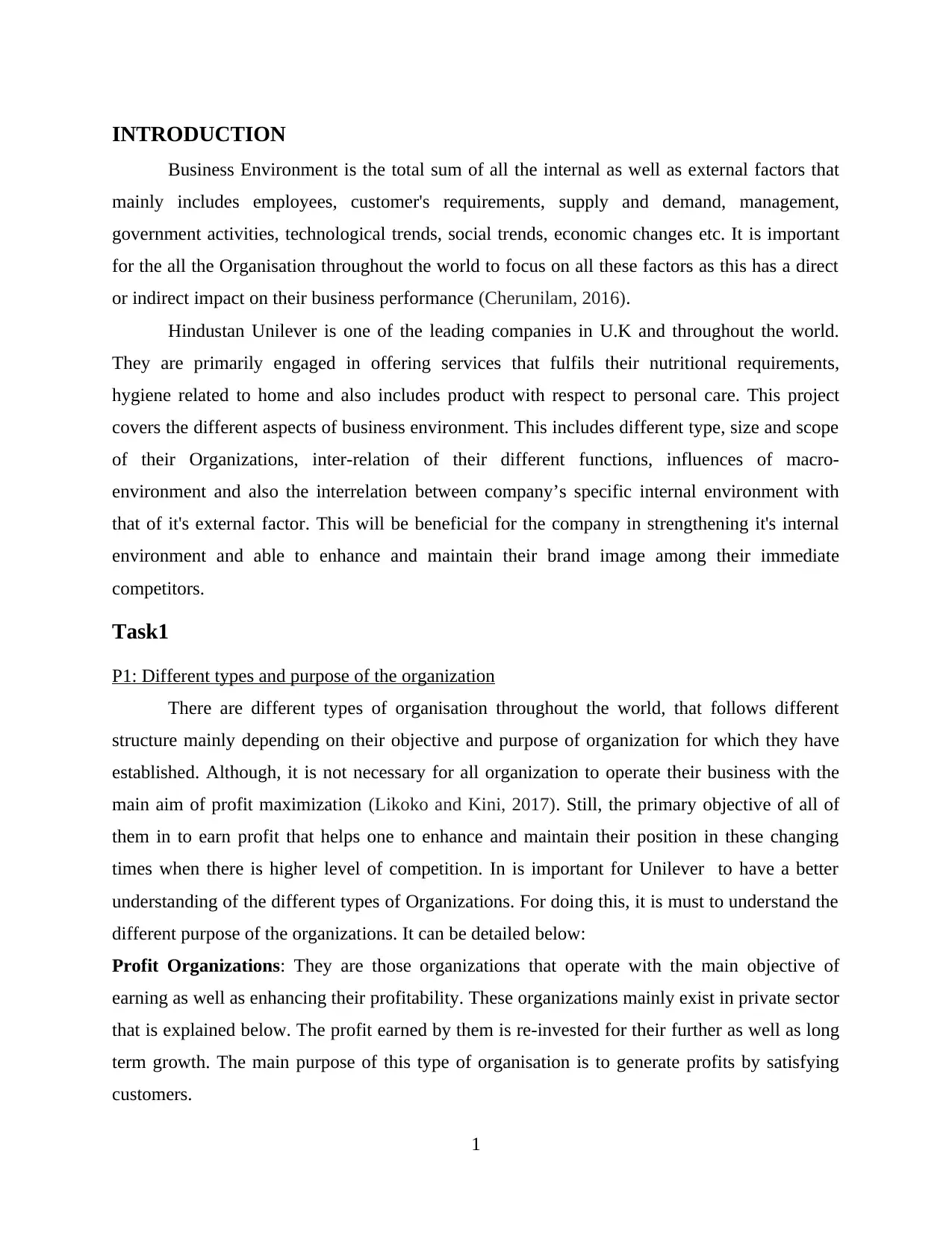
INTRODUCTION
Business Environment is the total sum of all the internal as well as external factors that
mainly includes employees, customer's requirements, supply and demand, management,
government activities, technological trends, social trends, economic changes etc. It is important
for the all the Organisation throughout the world to focus on all these factors as this has a direct
or indirect impact on their business performance (Cherunilam, 2016).
Hindustan Unilever is one of the leading companies in U.K and throughout the world.
They are primarily engaged in offering services that fulfils their nutritional requirements,
hygiene related to home and also includes product with respect to personal care. This project
covers the different aspects of business environment. This includes different type, size and scope
of their Organizations, inter-relation of their different functions, influences of macro-
environment and also the interrelation between company’s specific internal environment with
that of it's external factor. This will be beneficial for the company in strengthening it's internal
environment and able to enhance and maintain their brand image among their immediate
competitors.
Task1
P1: Different types and purpose of the organization
There are different types of organisation throughout the world, that follows different
structure mainly depending on their objective and purpose of organization for which they have
established. Although, it is not necessary for all organization to operate their business with the
main aim of profit maximization (Likoko and Kini, 2017). Still, the primary objective of all of
them in to earn profit that helps one to enhance and maintain their position in these changing
times when there is higher level of competition. In is important for Unilever to have a better
understanding of the different types of Organizations. For doing this, it is must to understand the
different purpose of the organizations. It can be detailed below:
Profit Organizations: They are those organizations that operate with the main objective of
earning as well as enhancing their profitability. These organizations mainly exist in private sector
that is explained below. The profit earned by them is re-invested for their further as well as long
term growth. The main purpose of this type of organisation is to generate profits by satisfying
customers.
1
Business Environment is the total sum of all the internal as well as external factors that
mainly includes employees, customer's requirements, supply and demand, management,
government activities, technological trends, social trends, economic changes etc. It is important
for the all the Organisation throughout the world to focus on all these factors as this has a direct
or indirect impact on their business performance (Cherunilam, 2016).
Hindustan Unilever is one of the leading companies in U.K and throughout the world.
They are primarily engaged in offering services that fulfils their nutritional requirements,
hygiene related to home and also includes product with respect to personal care. This project
covers the different aspects of business environment. This includes different type, size and scope
of their Organizations, inter-relation of their different functions, influences of macro-
environment and also the interrelation between company’s specific internal environment with
that of it's external factor. This will be beneficial for the company in strengthening it's internal
environment and able to enhance and maintain their brand image among their immediate
competitors.
Task1
P1: Different types and purpose of the organization
There are different types of organisation throughout the world, that follows different
structure mainly depending on their objective and purpose of organization for which they have
established. Although, it is not necessary for all organization to operate their business with the
main aim of profit maximization (Likoko and Kini, 2017). Still, the primary objective of all of
them in to earn profit that helps one to enhance and maintain their position in these changing
times when there is higher level of competition. In is important for Unilever to have a better
understanding of the different types of Organizations. For doing this, it is must to understand the
different purpose of the organizations. It can be detailed below:
Profit Organizations: They are those organizations that operate with the main objective of
earning as well as enhancing their profitability. These organizations mainly exist in private sector
that is explained below. The profit earned by them is re-invested for their further as well as long
term growth. The main purpose of this type of organisation is to generate profits by satisfying
customers.
1
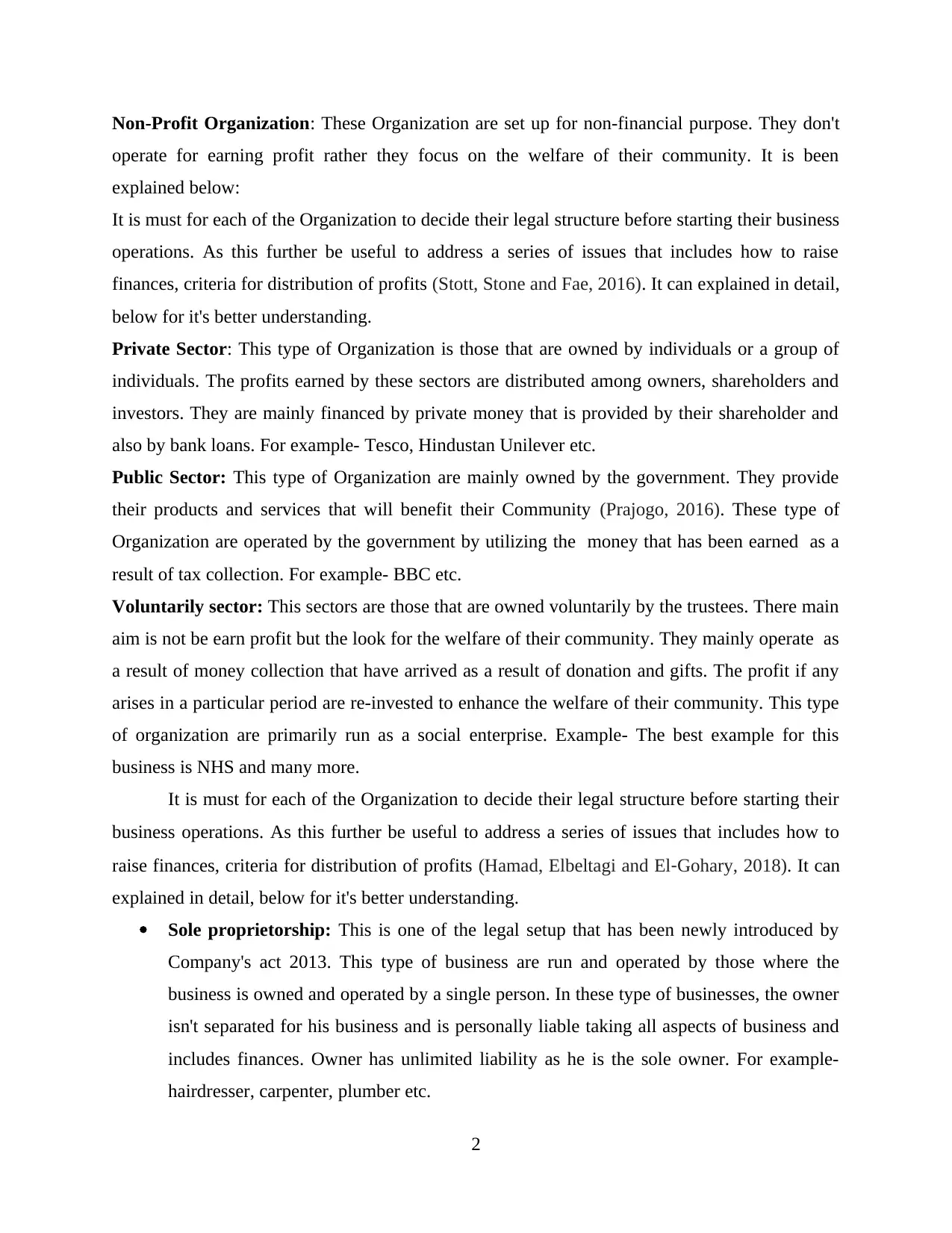
Non-Profit Organization: These Organization are set up for non-financial purpose. They don't
operate for earning profit rather they focus on the welfare of their community. It is been
explained below:
It is must for each of the Organization to decide their legal structure before starting their business
operations. As this further be useful to address a series of issues that includes how to raise
finances, criteria for distribution of profits (Stott, Stone and Fae, 2016). It can explained in detail,
below for it's better understanding.
Private Sector: This type of Organization is those that are owned by individuals or a group of
individuals. The profits earned by these sectors are distributed among owners, shareholders and
investors. They are mainly financed by private money that is provided by their shareholder and
also by bank loans. For example- Tesco, Hindustan Unilever etc.
Public Sector: This type of Organization are mainly owned by the government. They provide
their products and services that will benefit their Community (Prajogo, 2016). These type of
Organization are operated by the government by utilizing the money that has been earned as a
result of tax collection. For example- BBC etc.
Voluntarily sector: This sectors are those that are owned voluntarily by the trustees. There main
aim is not be earn profit but the look for the welfare of their community. They mainly operate as
a result of money collection that have arrived as a result of donation and gifts. The profit if any
arises in a particular period are re-invested to enhance the welfare of their community. This type
of organization are primarily run as a social enterprise. Example- The best example for this
business is NHS and many more.
It is must for each of the Organization to decide their legal structure before starting their
business operations. As this further be useful to address a series of issues that includes how to
raise finances, criteria for distribution of profits (Hamad, Elbeltagi and El‐Gohary, 2018). It can
explained in detail, below for it's better understanding.
Sole proprietorship: This is one of the legal setup that has been newly introduced by
Company's act 2013. This type of business are run and operated by those where the
business is owned and operated by a single person. In these type of businesses, the owner
isn't separated for his business and is personally liable taking all aspects of business and
includes finances. Owner has unlimited liability as he is the sole owner. For example-
hairdresser, carpenter, plumber etc.
2
operate for earning profit rather they focus on the welfare of their community. It is been
explained below:
It is must for each of the Organization to decide their legal structure before starting their business
operations. As this further be useful to address a series of issues that includes how to raise
finances, criteria for distribution of profits (Stott, Stone and Fae, 2016). It can explained in detail,
below for it's better understanding.
Private Sector: This type of Organization is those that are owned by individuals or a group of
individuals. The profits earned by these sectors are distributed among owners, shareholders and
investors. They are mainly financed by private money that is provided by their shareholder and
also by bank loans. For example- Tesco, Hindustan Unilever etc.
Public Sector: This type of Organization are mainly owned by the government. They provide
their products and services that will benefit their Community (Prajogo, 2016). These type of
Organization are operated by the government by utilizing the money that has been earned as a
result of tax collection. For example- BBC etc.
Voluntarily sector: This sectors are those that are owned voluntarily by the trustees. There main
aim is not be earn profit but the look for the welfare of their community. They mainly operate as
a result of money collection that have arrived as a result of donation and gifts. The profit if any
arises in a particular period are re-invested to enhance the welfare of their community. This type
of organization are primarily run as a social enterprise. Example- The best example for this
business is NHS and many more.
It is must for each of the Organization to decide their legal structure before starting their
business operations. As this further be useful to address a series of issues that includes how to
raise finances, criteria for distribution of profits (Hamad, Elbeltagi and El‐Gohary, 2018). It can
explained in detail, below for it's better understanding.
Sole proprietorship: This is one of the legal setup that has been newly introduced by
Company's act 2013. This type of business are run and operated by those where the
business is owned and operated by a single person. In these type of businesses, the owner
isn't separated for his business and is personally liable taking all aspects of business and
includes finances. Owner has unlimited liability as he is the sole owner. For example-
hairdresser, carpenter, plumber etc.
2
Secure Best Marks with AI Grader
Need help grading? Try our AI Grader for instant feedback on your assignments.
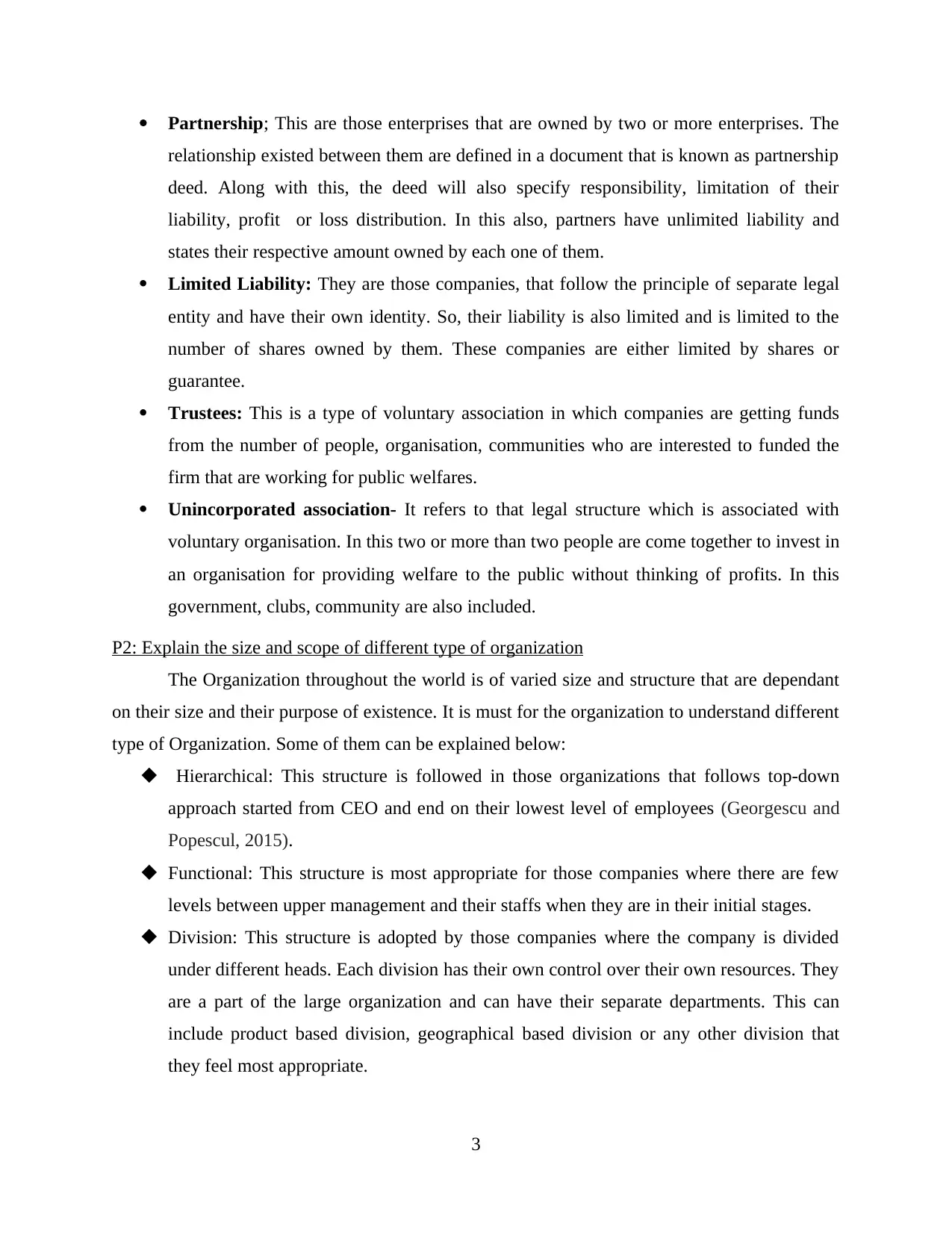
Partnership; This are those enterprises that are owned by two or more enterprises. The
relationship existed between them are defined in a document that is known as partnership
deed. Along with this, the deed will also specify responsibility, limitation of their
liability, profit or loss distribution. In this also, partners have unlimited liability and
states their respective amount owned by each one of them.
Limited Liability: They are those companies, that follow the principle of separate legal
entity and have their own identity. So, their liability is also limited and is limited to the
number of shares owned by them. These companies are either limited by shares or
guarantee.
Trustees: This is a type of voluntary association in which companies are getting funds
from the number of people, organisation, communities who are interested to funded the
firm that are working for public welfares.
Unincorporated association- It refers to that legal structure which is associated with
voluntary organisation. In this two or more than two people are come together to invest in
an organisation for providing welfare to the public without thinking of profits. In this
government, clubs, community are also included.
P2: Explain the size and scope of different type of organization
The Organization throughout the world is of varied size and structure that are dependant
on their size and their purpose of existence. It is must for the organization to understand different
type of Organization. Some of them can be explained below:
Hierarchical: This structure is followed in those organizations that follows top-down
approach started from CEO and end on their lowest level of employees (Georgescu and
Popescul, 2015).
Functional: This structure is most appropriate for those companies where there are few
levels between upper management and their staffs when they are in their initial stages.
Division: This structure is adopted by those companies where the company is divided
under different heads. Each division has their own control over their own resources. They
are a part of the large organization and can have their separate departments. This can
include product based division, geographical based division or any other division that
they feel most appropriate.
3
relationship existed between them are defined in a document that is known as partnership
deed. Along with this, the deed will also specify responsibility, limitation of their
liability, profit or loss distribution. In this also, partners have unlimited liability and
states their respective amount owned by each one of them.
Limited Liability: They are those companies, that follow the principle of separate legal
entity and have their own identity. So, their liability is also limited and is limited to the
number of shares owned by them. These companies are either limited by shares or
guarantee.
Trustees: This is a type of voluntary association in which companies are getting funds
from the number of people, organisation, communities who are interested to funded the
firm that are working for public welfares.
Unincorporated association- It refers to that legal structure which is associated with
voluntary organisation. In this two or more than two people are come together to invest in
an organisation for providing welfare to the public without thinking of profits. In this
government, clubs, community are also included.
P2: Explain the size and scope of different type of organization
The Organization throughout the world is of varied size and structure that are dependant
on their size and their purpose of existence. It is must for the organization to understand different
type of Organization. Some of them can be explained below:
Hierarchical: This structure is followed in those organizations that follows top-down
approach started from CEO and end on their lowest level of employees (Georgescu and
Popescul, 2015).
Functional: This structure is most appropriate for those companies where there are few
levels between upper management and their staffs when they are in their initial stages.
Division: This structure is adopted by those companies where the company is divided
under different heads. Each division has their own control over their own resources. They
are a part of the large organization and can have their separate departments. This can
include product based division, geographical based division or any other division that
they feel most appropriate.
3
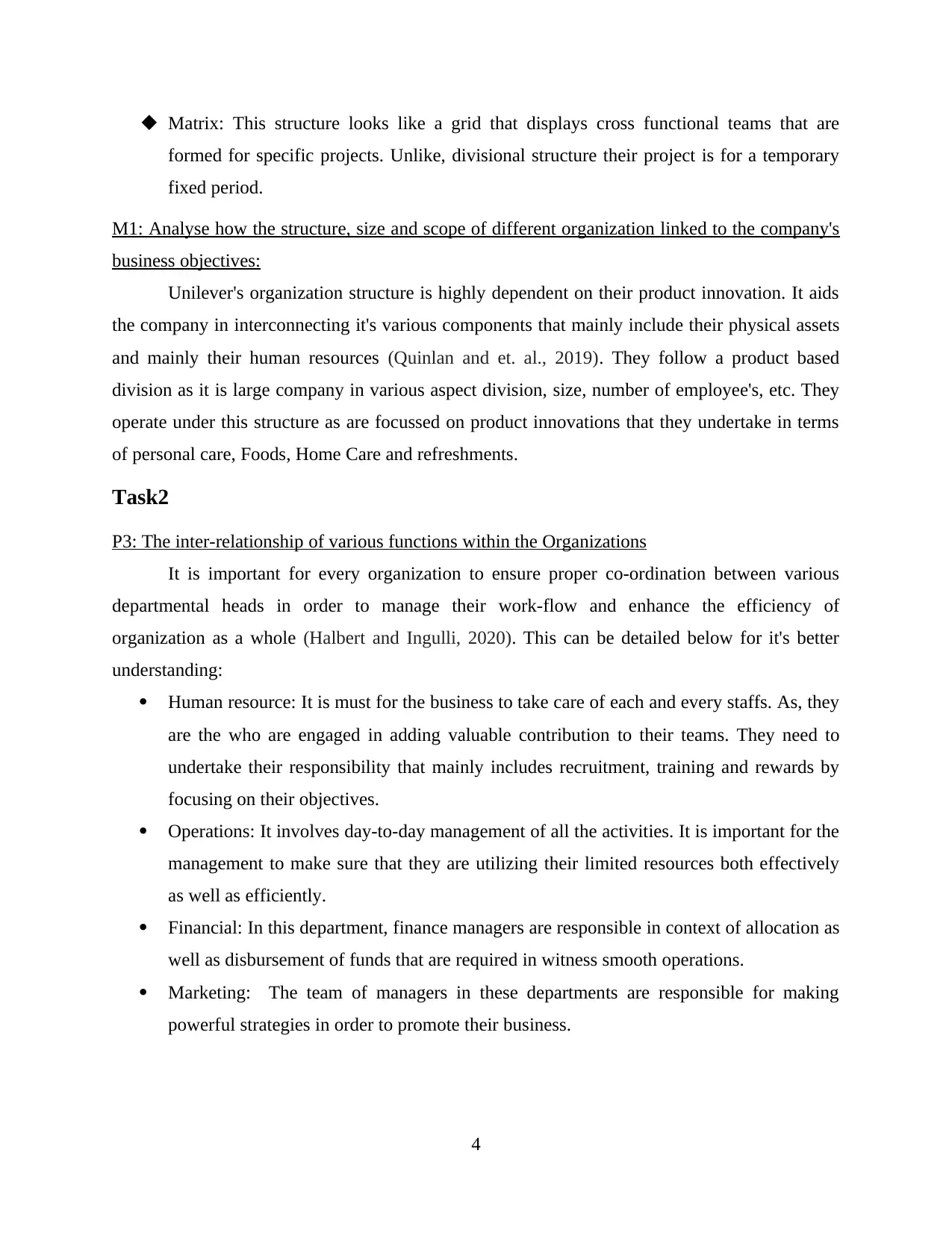
Matrix: This structure looks like a grid that displays cross functional teams that are
formed for specific projects. Unlike, divisional structure their project is for a temporary
fixed period.
M1: Analyse how the structure, size and scope of different organization linked to the company's
business objectives:
Unilever's organization structure is highly dependent on their product innovation. It aids
the company in interconnecting it's various components that mainly include their physical assets
and mainly their human resources (Quinlan and et. al., 2019). They follow a product based
division as it is large company in various aspect division, size, number of employee's, etc. They
operate under this structure as are focussed on product innovations that they undertake in terms
of personal care, Foods, Home Care and refreshments.
Task2
P3: The inter-relationship of various functions within the Organizations
It is important for every organization to ensure proper co-ordination between various
departmental heads in order to manage their work-flow and enhance the efficiency of
organization as a whole (Halbert and Ingulli, 2020). This can be detailed below for it's better
understanding:
Human resource: It is must for the business to take care of each and every staffs. As, they
are the who are engaged in adding valuable contribution to their teams. They need to
undertake their responsibility that mainly includes recruitment, training and rewards by
focusing on their objectives.
Operations: It involves day-to-day management of all the activities. It is important for the
management to make sure that they are utilizing their limited resources both effectively
as well as efficiently.
Financial: In this department, finance managers are responsible in context of allocation as
well as disbursement of funds that are required in witness smooth operations.
Marketing: The team of managers in these departments are responsible for making
powerful strategies in order to promote their business.
4
formed for specific projects. Unlike, divisional structure their project is for a temporary
fixed period.
M1: Analyse how the structure, size and scope of different organization linked to the company's
business objectives:
Unilever's organization structure is highly dependent on their product innovation. It aids
the company in interconnecting it's various components that mainly include their physical assets
and mainly their human resources (Quinlan and et. al., 2019). They follow a product based
division as it is large company in various aspect division, size, number of employee's, etc. They
operate under this structure as are focussed on product innovations that they undertake in terms
of personal care, Foods, Home Care and refreshments.
Task2
P3: The inter-relationship of various functions within the Organizations
It is important for every organization to ensure proper co-ordination between various
departmental heads in order to manage their work-flow and enhance the efficiency of
organization as a whole (Halbert and Ingulli, 2020). This can be detailed below for it's better
understanding:
Human resource: It is must for the business to take care of each and every staffs. As, they
are the who are engaged in adding valuable contribution to their teams. They need to
undertake their responsibility that mainly includes recruitment, training and rewards by
focusing on their objectives.
Operations: It involves day-to-day management of all the activities. It is important for the
management to make sure that they are utilizing their limited resources both effectively
as well as efficiently.
Financial: In this department, finance managers are responsible in context of allocation as
well as disbursement of funds that are required in witness smooth operations.
Marketing: The team of managers in these departments are responsible for making
powerful strategies in order to promote their business.
4
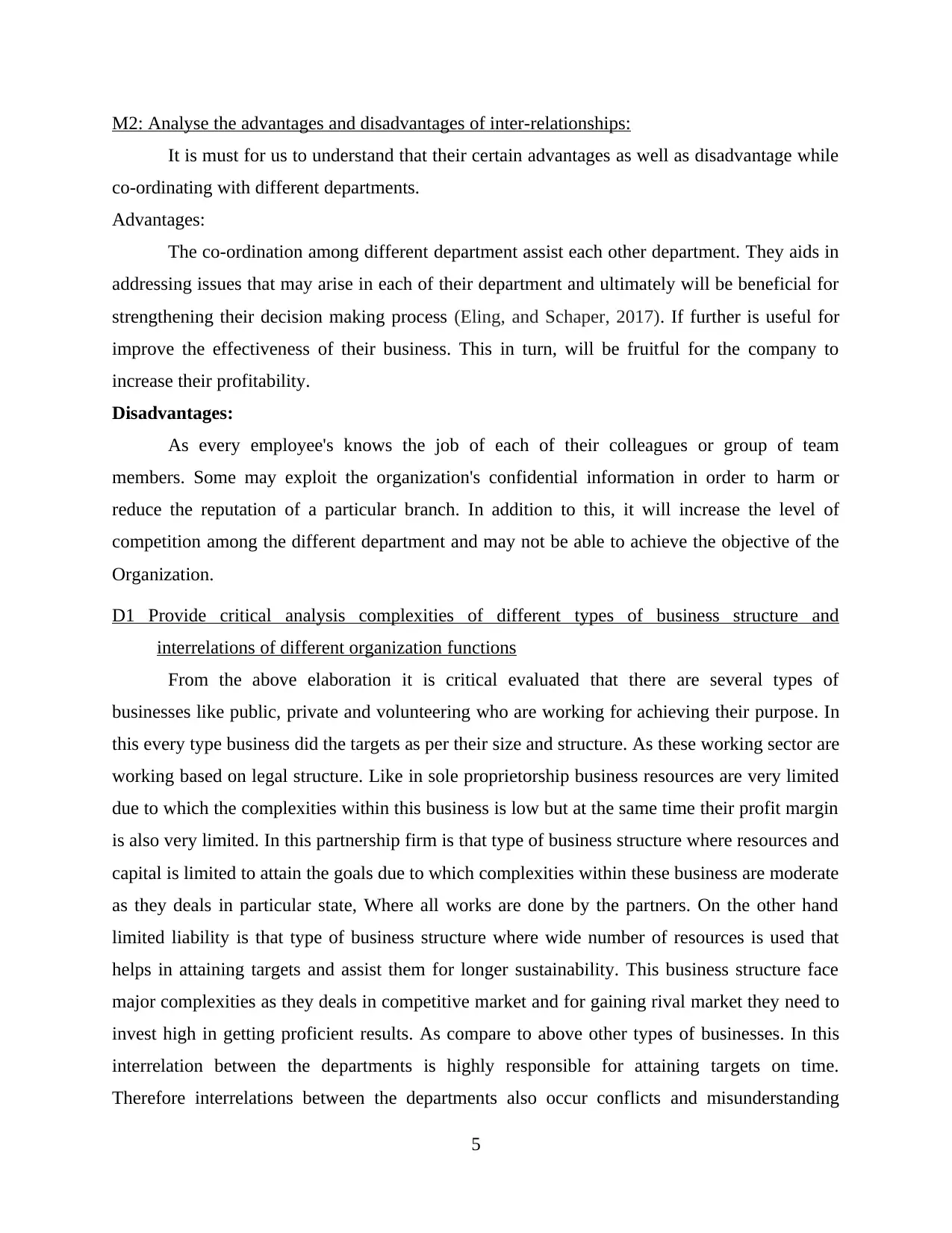
M2: Analyse the advantages and disadvantages of inter-relationships:
It is must for us to understand that their certain advantages as well as disadvantage while
co-ordinating with different departments.
Advantages:
The co-ordination among different department assist each other department. They aids in
addressing issues that may arise in each of their department and ultimately will be beneficial for
strengthening their decision making process (Eling, and Schaper, 2017). If further is useful for
improve the effectiveness of their business. This in turn, will be fruitful for the company to
increase their profitability.
Disadvantages:
As every employee's knows the job of each of their colleagues or group of team
members. Some may exploit the organization's confidential information in order to harm or
reduce the reputation of a particular branch. In addition to this, it will increase the level of
competition among the different department and may not be able to achieve the objective of the
Organization.
D1 Provide critical analysis complexities of different types of business structure and
interrelations of different organization functions
From the above elaboration it is critical evaluated that there are several types of
businesses like public, private and volunteering who are working for achieving their purpose. In
this every type business did the targets as per their size and structure. As these working sector are
working based on legal structure. Like in sole proprietorship business resources are very limited
due to which the complexities within this business is low but at the same time their profit margin
is also very limited. In this partnership firm is that type of business structure where resources and
capital is limited to attain the goals due to which complexities within these business are moderate
as they deals in particular state, Where all works are done by the partners. On the other hand
limited liability is that type of business structure where wide number of resources is used that
helps in attaining targets and assist them for longer sustainability. This business structure face
major complexities as they deals in competitive market and for gaining rival market they need to
invest high in getting proficient results. As compare to above other types of businesses. In this
interrelation between the departments is highly responsible for attaining targets on time.
Therefore interrelations between the departments also occur conflicts and misunderstanding
5
It is must for us to understand that their certain advantages as well as disadvantage while
co-ordinating with different departments.
Advantages:
The co-ordination among different department assist each other department. They aids in
addressing issues that may arise in each of their department and ultimately will be beneficial for
strengthening their decision making process (Eling, and Schaper, 2017). If further is useful for
improve the effectiveness of their business. This in turn, will be fruitful for the company to
increase their profitability.
Disadvantages:
As every employee's knows the job of each of their colleagues or group of team
members. Some may exploit the organization's confidential information in order to harm or
reduce the reputation of a particular branch. In addition to this, it will increase the level of
competition among the different department and may not be able to achieve the objective of the
Organization.
D1 Provide critical analysis complexities of different types of business structure and
interrelations of different organization functions
From the above elaboration it is critical evaluated that there are several types of
businesses like public, private and volunteering who are working for achieving their purpose. In
this every type business did the targets as per their size and structure. As these working sector are
working based on legal structure. Like in sole proprietorship business resources are very limited
due to which the complexities within this business is low but at the same time their profit margin
is also very limited. In this partnership firm is that type of business structure where resources and
capital is limited to attain the goals due to which complexities within these business are moderate
as they deals in particular state, Where all works are done by the partners. On the other hand
limited liability is that type of business structure where wide number of resources is used that
helps in attaining targets and assist them for longer sustainability. This business structure face
major complexities as they deals in competitive market and for gaining rival market they need to
invest high in getting proficient results. As compare to above other types of businesses. In this
interrelation between the departments is highly responsible for attaining targets on time.
Therefore interrelations between the departments also occur conflicts and misunderstanding
5
Paraphrase This Document
Need a fresh take? Get an instant paraphrase of this document with our AI Paraphraser
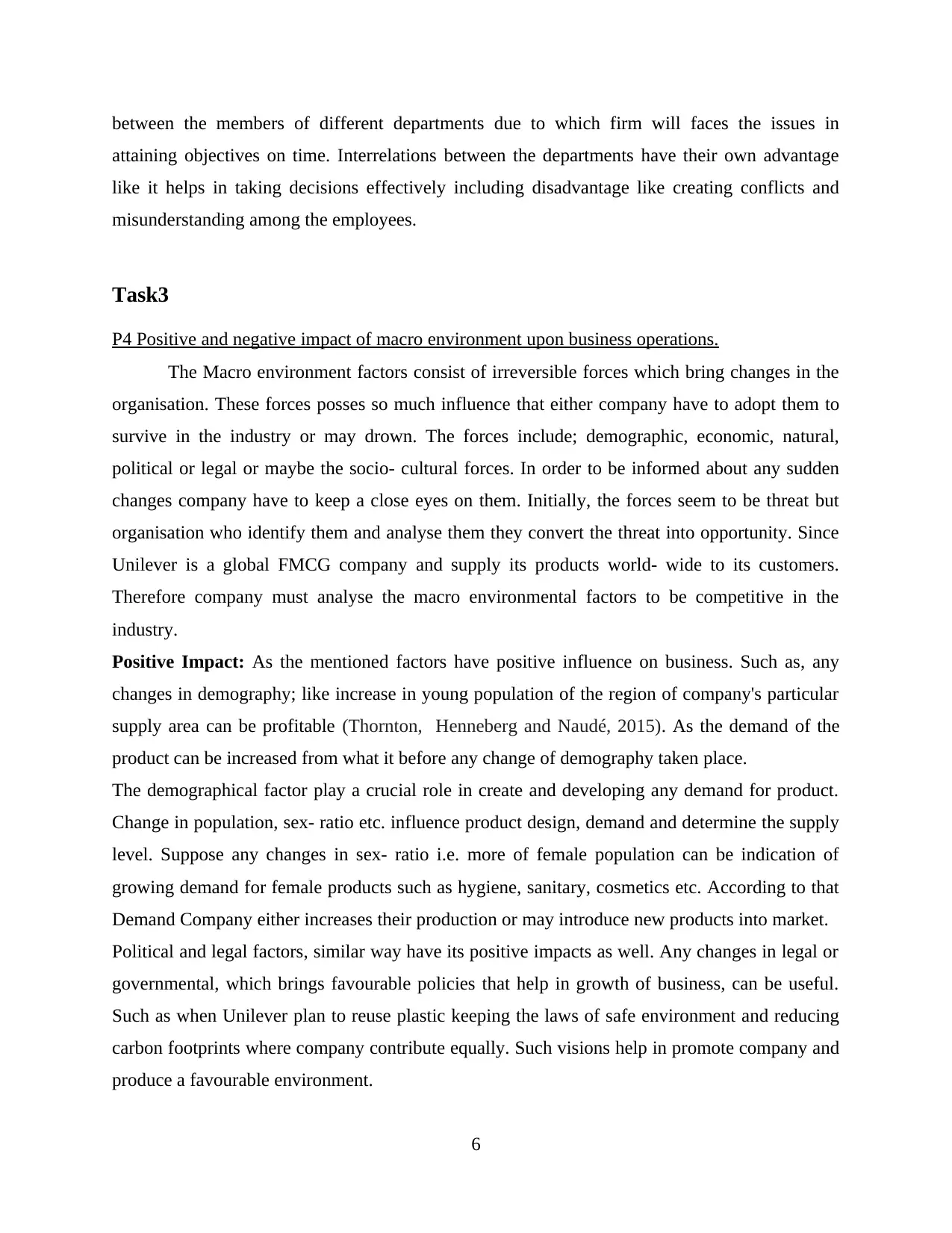
between the members of different departments due to which firm will faces the issues in
attaining objectives on time. Interrelations between the departments have their own advantage
like it helps in taking decisions effectively including disadvantage like creating conflicts and
misunderstanding among the employees.
Task3
P4 Positive and negative impact of macro environment upon business operations.
The Macro environment factors consist of irreversible forces which bring changes in the
organisation. These forces posses so much influence that either company have to adopt them to
survive in the industry or may drown. The forces include; demographic, economic, natural,
political or legal or maybe the socio- cultural forces. In order to be informed about any sudden
changes company have to keep a close eyes on them. Initially, the forces seem to be threat but
organisation who identify them and analyse them they convert the threat into opportunity. Since
Unilever is a global FMCG company and supply its products world- wide to its customers.
Therefore company must analyse the macro environmental factors to be competitive in the
industry.
Positive Impact: As the mentioned factors have positive influence on business. Such as, any
changes in demography; like increase in young population of the region of company's particular
supply area can be profitable (Thornton, Henneberg and Naudé, 2015). As the demand of the
product can be increased from what it before any change of demography taken place.
The demographical factor play a crucial role in create and developing any demand for product.
Change in population, sex- ratio etc. influence product design, demand and determine the supply
level. Suppose any changes in sex- ratio i.e. more of female population can be indication of
growing demand for female products such as hygiene, sanitary, cosmetics etc. According to that
Demand Company either increases their production or may introduce new products into market.
Political and legal factors, similar way have its positive impacts as well. Any changes in legal or
governmental, which brings favourable policies that help in growth of business, can be useful.
Such as when Unilever plan to reuse plastic keeping the laws of safe environment and reducing
carbon footprints where company contribute equally. Such visions help in promote company and
produce a favourable environment.
6
attaining objectives on time. Interrelations between the departments have their own advantage
like it helps in taking decisions effectively including disadvantage like creating conflicts and
misunderstanding among the employees.
Task3
P4 Positive and negative impact of macro environment upon business operations.
The Macro environment factors consist of irreversible forces which bring changes in the
organisation. These forces posses so much influence that either company have to adopt them to
survive in the industry or may drown. The forces include; demographic, economic, natural,
political or legal or maybe the socio- cultural forces. In order to be informed about any sudden
changes company have to keep a close eyes on them. Initially, the forces seem to be threat but
organisation who identify them and analyse them they convert the threat into opportunity. Since
Unilever is a global FMCG company and supply its products world- wide to its customers.
Therefore company must analyse the macro environmental factors to be competitive in the
industry.
Positive Impact: As the mentioned factors have positive influence on business. Such as, any
changes in demography; like increase in young population of the region of company's particular
supply area can be profitable (Thornton, Henneberg and Naudé, 2015). As the demand of the
product can be increased from what it before any change of demography taken place.
The demographical factor play a crucial role in create and developing any demand for product.
Change in population, sex- ratio etc. influence product design, demand and determine the supply
level. Suppose any changes in sex- ratio i.e. more of female population can be indication of
growing demand for female products such as hygiene, sanitary, cosmetics etc. According to that
Demand Company either increases their production or may introduce new products into market.
Political and legal factors, similar way have its positive impacts as well. Any changes in legal or
governmental, which brings favourable policies that help in growth of business, can be useful.
Such as when Unilever plan to reuse plastic keeping the laws of safe environment and reducing
carbon footprints where company contribute equally. Such visions help in promote company and
produce a favourable environment.
6
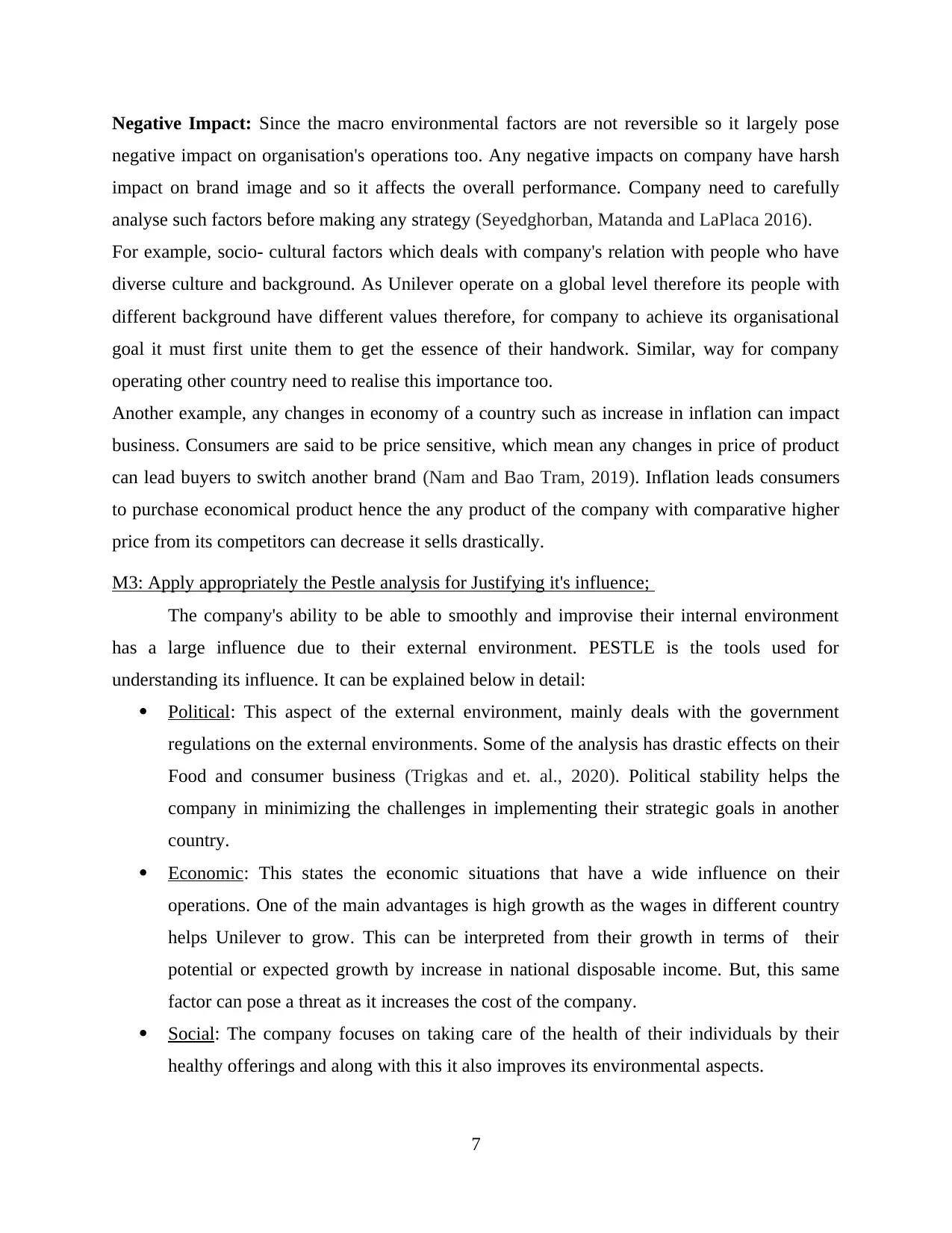
Negative Impact: Since the macro environmental factors are not reversible so it largely pose
negative impact on organisation's operations too. Any negative impacts on company have harsh
impact on brand image and so it affects the overall performance. Company need to carefully
analyse such factors before making any strategy (Seyedghorban, Matanda and LaPlaca 2016).
For example, socio- cultural factors which deals with company's relation with people who have
diverse culture and background. As Unilever operate on a global level therefore its people with
different background have different values therefore, for company to achieve its organisational
goal it must first unite them to get the essence of their handwork. Similar, way for company
operating other country need to realise this importance too.
Another example, any changes in economy of a country such as increase in inflation can impact
business. Consumers are said to be price sensitive, which mean any changes in price of product
can lead buyers to switch another brand (Nam and Bao Tram, 2019). Inflation leads consumers
to purchase economical product hence the any product of the company with comparative higher
price from its competitors can decrease it sells drastically.
M3: Apply appropriately the Pestle analysis for Justifying it's influence;
The company's ability to be able to smoothly and improvise their internal environment
has a large influence due to their external environment. PESTLE is the tools used for
understanding its influence. It can be explained below in detail:
Political: This aspect of the external environment, mainly deals with the government
regulations on the external environments. Some of the analysis has drastic effects on their
Food and consumer business (Trigkas and et. al., 2020). Political stability helps the
company in minimizing the challenges in implementing their strategic goals in another
country.
Economic: This states the economic situations that have a wide influence on their
operations. One of the main advantages is high growth as the wages in different country
helps Unilever to grow. This can be interpreted from their growth in terms of their
potential or expected growth by increase in national disposable income. But, this same
factor can pose a threat as it increases the cost of the company.
Social: The company focuses on taking care of the health of their individuals by their
healthy offerings and along with this it also improves its environmental aspects.
7
negative impact on organisation's operations too. Any negative impacts on company have harsh
impact on brand image and so it affects the overall performance. Company need to carefully
analyse such factors before making any strategy (Seyedghorban, Matanda and LaPlaca 2016).
For example, socio- cultural factors which deals with company's relation with people who have
diverse culture and background. As Unilever operate on a global level therefore its people with
different background have different values therefore, for company to achieve its organisational
goal it must first unite them to get the essence of their handwork. Similar, way for company
operating other country need to realise this importance too.
Another example, any changes in economy of a country such as increase in inflation can impact
business. Consumers are said to be price sensitive, which mean any changes in price of product
can lead buyers to switch another brand (Nam and Bao Tram, 2019). Inflation leads consumers
to purchase economical product hence the any product of the company with comparative higher
price from its competitors can decrease it sells drastically.
M3: Apply appropriately the Pestle analysis for Justifying it's influence;
The company's ability to be able to smoothly and improvise their internal environment
has a large influence due to their external environment. PESTLE is the tools used for
understanding its influence. It can be explained below in detail:
Political: This aspect of the external environment, mainly deals with the government
regulations on the external environments. Some of the analysis has drastic effects on their
Food and consumer business (Trigkas and et. al., 2020). Political stability helps the
company in minimizing the challenges in implementing their strategic goals in another
country.
Economic: This states the economic situations that have a wide influence on their
operations. One of the main advantages is high growth as the wages in different country
helps Unilever to grow. This can be interpreted from their growth in terms of their
potential or expected growth by increase in national disposable income. But, this same
factor can pose a threat as it increases the cost of the company.
Social: The company focuses on taking care of the health of their individuals by their
healthy offerings and along with this it also improves its environmental aspects.
7
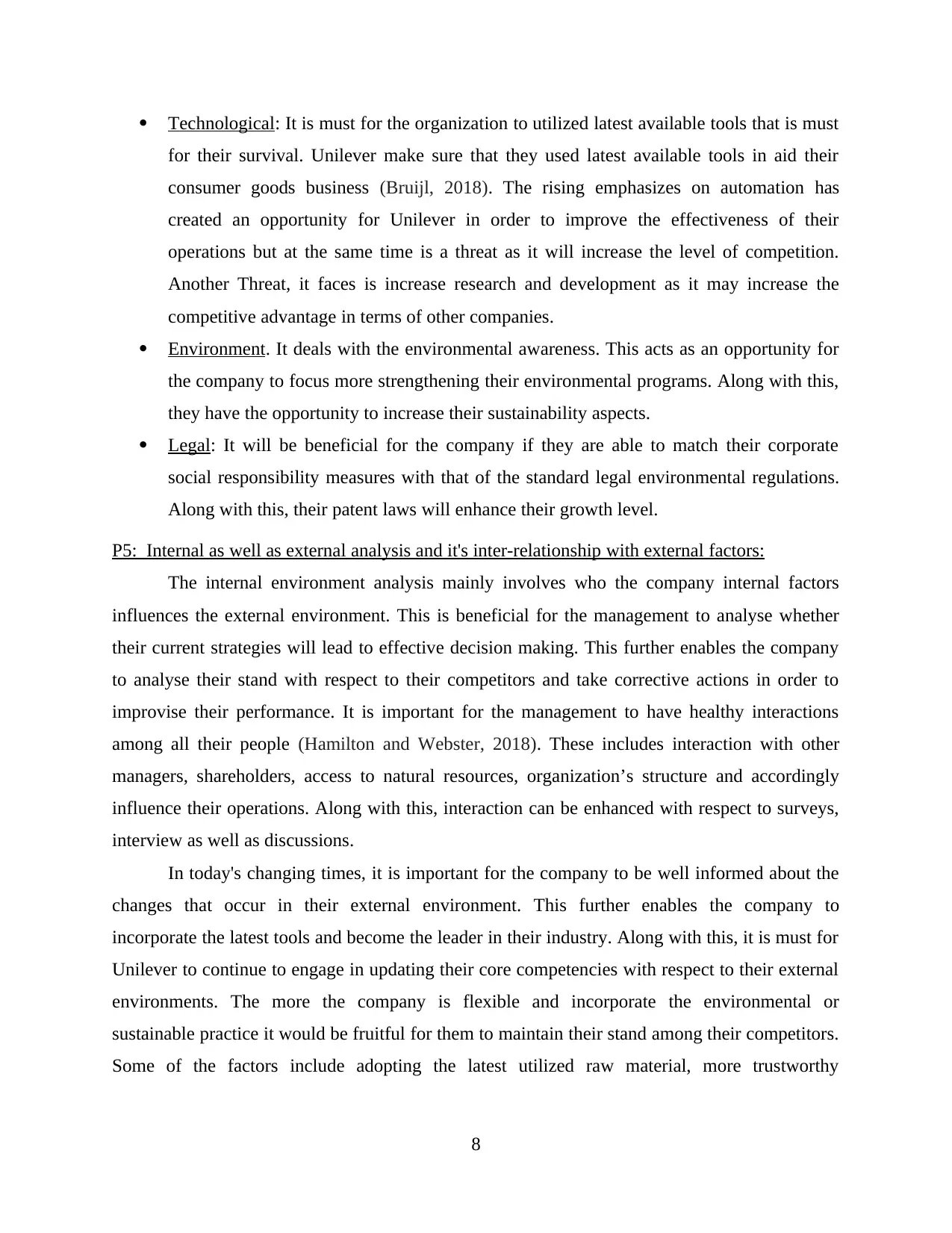
Technological: It is must for the organization to utilized latest available tools that is must
for their survival. Unilever make sure that they used latest available tools in aid their
consumer goods business (Bruijl, 2018). The rising emphasizes on automation has
created an opportunity for Unilever in order to improve the effectiveness of their
operations but at the same time is a threat as it will increase the level of competition.
Another Threat, it faces is increase research and development as it may increase the
competitive advantage in terms of other companies.
Environment. It deals with the environmental awareness. This acts as an opportunity for
the company to focus more strengthening their environmental programs. Along with this,
they have the opportunity to increase their sustainability aspects.
Legal: It will be beneficial for the company if they are able to match their corporate
social responsibility measures with that of the standard legal environmental regulations.
Along with this, their patent laws will enhance their growth level.
P5: Internal as well as external analysis and it's inter-relationship with external factors:
The internal environment analysis mainly involves who the company internal factors
influences the external environment. This is beneficial for the management to analyse whether
their current strategies will lead to effective decision making. This further enables the company
to analyse their stand with respect to their competitors and take corrective actions in order to
improvise their performance. It is important for the management to have healthy interactions
among all their people (Hamilton and Webster, 2018). These includes interaction with other
managers, shareholders, access to natural resources, organization’s structure and accordingly
influence their operations. Along with this, interaction can be enhanced with respect to surveys,
interview as well as discussions.
In today's changing times, it is important for the company to be well informed about the
changes that occur in their external environment. This further enables the company to
incorporate the latest tools and become the leader in their industry. Along with this, it is must for
Unilever to continue to engage in updating their core competencies with respect to their external
environments. The more the company is flexible and incorporate the environmental or
sustainable practice it would be fruitful for them to maintain their stand among their competitors.
Some of the factors include adopting the latest utilized raw material, more trustworthy
8
for their survival. Unilever make sure that they used latest available tools in aid their
consumer goods business (Bruijl, 2018). The rising emphasizes on automation has
created an opportunity for Unilever in order to improve the effectiveness of their
operations but at the same time is a threat as it will increase the level of competition.
Another Threat, it faces is increase research and development as it may increase the
competitive advantage in terms of other companies.
Environment. It deals with the environmental awareness. This acts as an opportunity for
the company to focus more strengthening their environmental programs. Along with this,
they have the opportunity to increase their sustainability aspects.
Legal: It will be beneficial for the company if they are able to match their corporate
social responsibility measures with that of the standard legal environmental regulations.
Along with this, their patent laws will enhance their growth level.
P5: Internal as well as external analysis and it's inter-relationship with external factors:
The internal environment analysis mainly involves who the company internal factors
influences the external environment. This is beneficial for the management to analyse whether
their current strategies will lead to effective decision making. This further enables the company
to analyse their stand with respect to their competitors and take corrective actions in order to
improvise their performance. It is important for the management to have healthy interactions
among all their people (Hamilton and Webster, 2018). These includes interaction with other
managers, shareholders, access to natural resources, organization’s structure and accordingly
influence their operations. Along with this, interaction can be enhanced with respect to surveys,
interview as well as discussions.
In today's changing times, it is important for the company to be well informed about the
changes that occur in their external environment. This further enables the company to
incorporate the latest tools and become the leader in their industry. Along with this, it is must for
Unilever to continue to engage in updating their core competencies with respect to their external
environments. The more the company is flexible and incorporate the environmental or
sustainable practice it would be fruitful for them to maintain their stand among their competitors.
Some of the factors include adopting the latest utilized raw material, more trustworthy
8
Secure Best Marks with AI Grader
Need help grading? Try our AI Grader for instant feedback on your assignments.
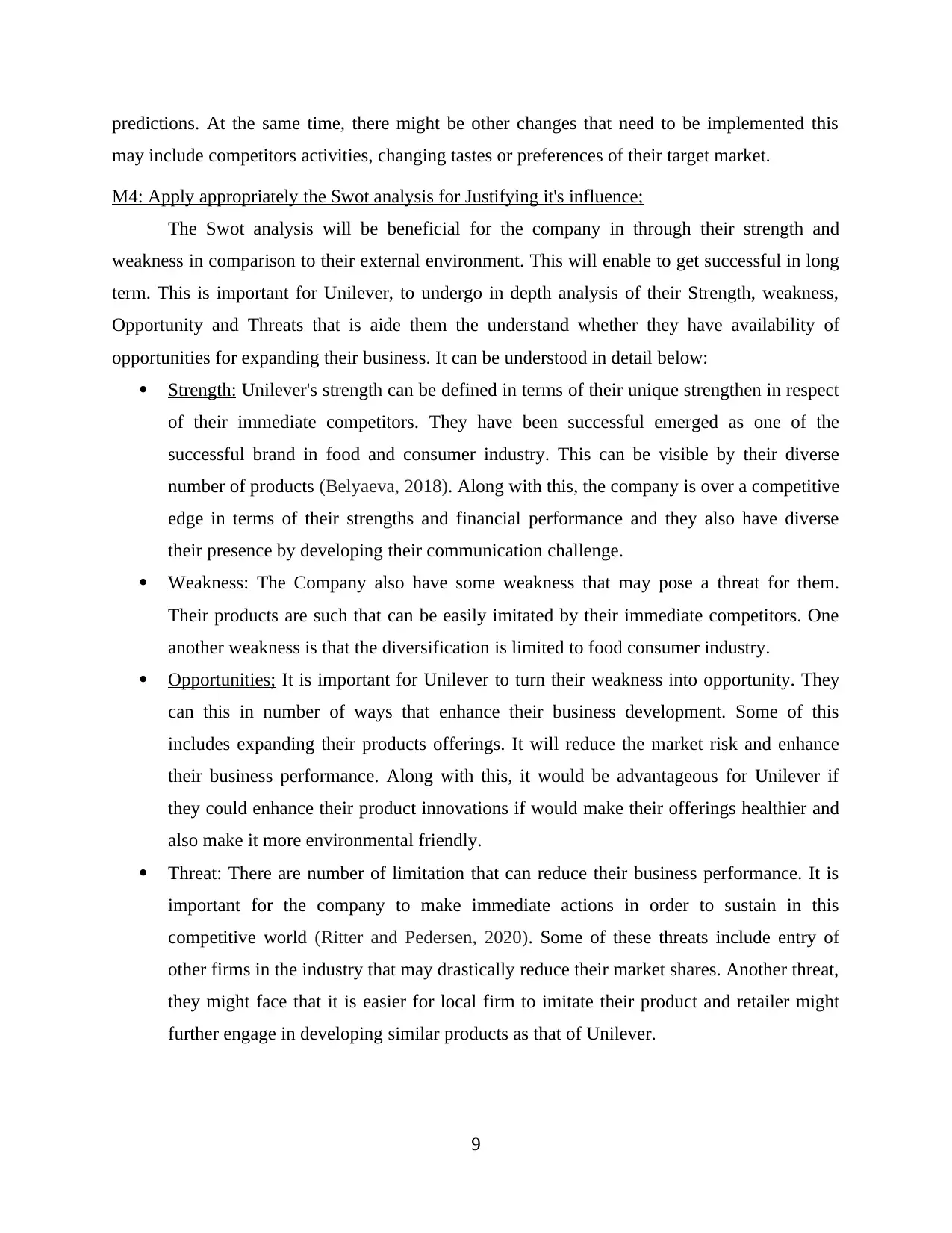
predictions. At the same time, there might be other changes that need to be implemented this
may include competitors activities, changing tastes or preferences of their target market.
M4: Apply appropriately the Swot analysis for Justifying it's influence;
The Swot analysis will be beneficial for the company in through their strength and
weakness in comparison to their external environment. This will enable to get successful in long
term. This is important for Unilever, to undergo in depth analysis of their Strength, weakness,
Opportunity and Threats that is aide them the understand whether they have availability of
opportunities for expanding their business. It can be understood in detail below:
Strength: Unilever's strength can be defined in terms of their unique strengthen in respect
of their immediate competitors. They have been successful emerged as one of the
successful brand in food and consumer industry. This can be visible by their diverse
number of products (Belyaeva, 2018). Along with this, the company is over a competitive
edge in terms of their strengths and financial performance and they also have diverse
their presence by developing their communication challenge.
Weakness: The Company also have some weakness that may pose a threat for them.
Their products are such that can be easily imitated by their immediate competitors. One
another weakness is that the diversification is limited to food consumer industry.
Opportunities; It is important for Unilever to turn their weakness into opportunity. They
can this in number of ways that enhance their business development. Some of this
includes expanding their products offerings. It will reduce the market risk and enhance
their business performance. Along with this, it would be advantageous for Unilever if
they could enhance their product innovations if would make their offerings healthier and
also make it more environmental friendly.
Threat: There are number of limitation that can reduce their business performance. It is
important for the company to make immediate actions in order to sustain in this
competitive world (Ritter and Pedersen, 2020). Some of these threats include entry of
other firms in the industry that may drastically reduce their market shares. Another threat,
they might face that it is easier for local firm to imitate their product and retailer might
further engage in developing similar products as that of Unilever.
9
may include competitors activities, changing tastes or preferences of their target market.
M4: Apply appropriately the Swot analysis for Justifying it's influence;
The Swot analysis will be beneficial for the company in through their strength and
weakness in comparison to their external environment. This will enable to get successful in long
term. This is important for Unilever, to undergo in depth analysis of their Strength, weakness,
Opportunity and Threats that is aide them the understand whether they have availability of
opportunities for expanding their business. It can be understood in detail below:
Strength: Unilever's strength can be defined in terms of their unique strengthen in respect
of their immediate competitors. They have been successful emerged as one of the
successful brand in food and consumer industry. This can be visible by their diverse
number of products (Belyaeva, 2018). Along with this, the company is over a competitive
edge in terms of their strengths and financial performance and they also have diverse
their presence by developing their communication challenge.
Weakness: The Company also have some weakness that may pose a threat for them.
Their products are such that can be easily imitated by their immediate competitors. One
another weakness is that the diversification is limited to food consumer industry.
Opportunities; It is important for Unilever to turn their weakness into opportunity. They
can this in number of ways that enhance their business development. Some of this
includes expanding their products offerings. It will reduce the market risk and enhance
their business performance. Along with this, it would be advantageous for Unilever if
they could enhance their product innovations if would make their offerings healthier and
also make it more environmental friendly.
Threat: There are number of limitation that can reduce their business performance. It is
important for the company to make immediate actions in order to sustain in this
competitive world (Ritter and Pedersen, 2020). Some of these threats include entry of
other firms in the industry that may drastically reduce their market shares. Another threat,
they might face that it is easier for local firm to imitate their product and retailer might
further engage in developing similar products as that of Unilever.
9
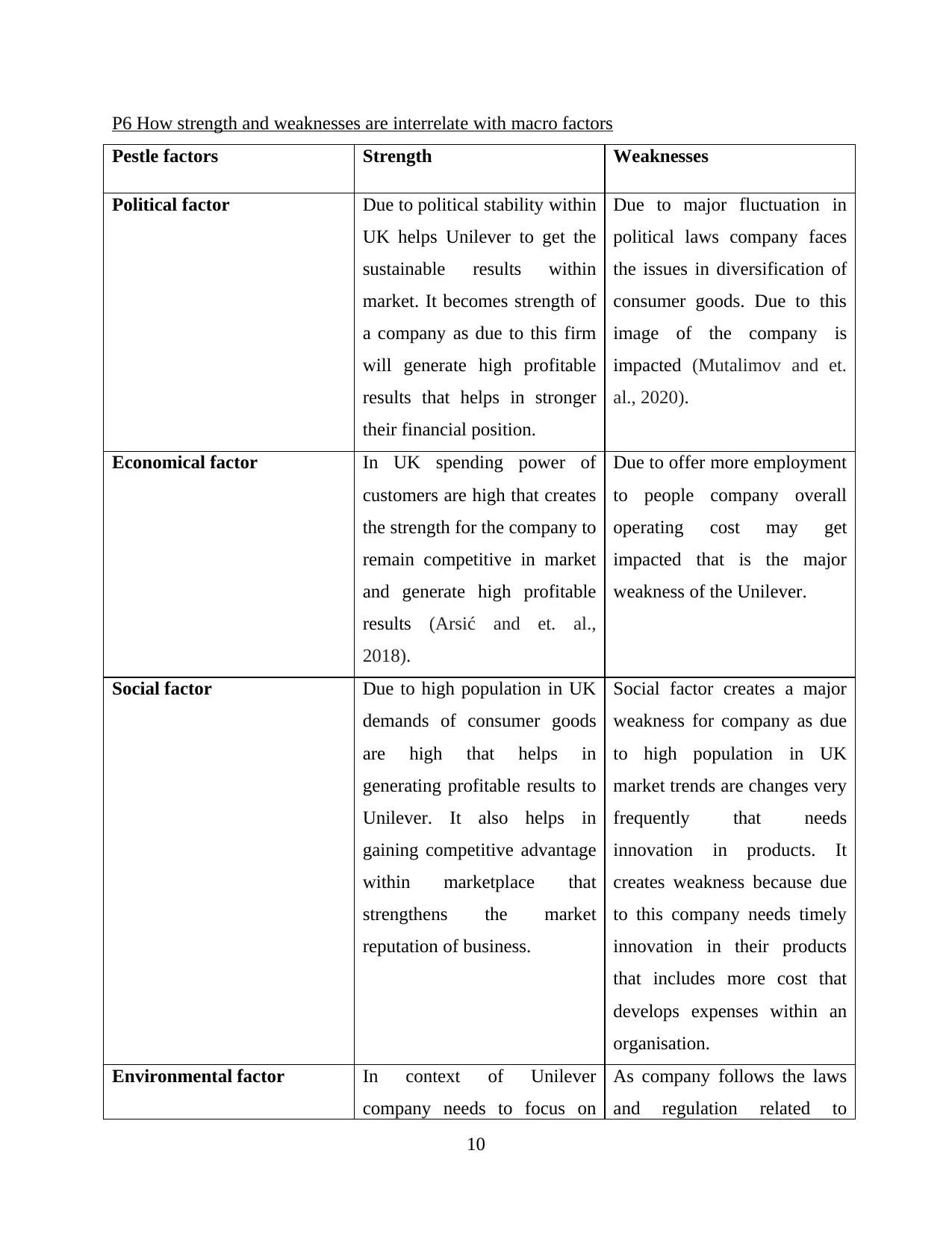
P6 How strength and weaknesses are interrelate with macro factors
Pestle factors Strength Weaknesses
Political factor Due to political stability within
UK helps Unilever to get the
sustainable results within
market. It becomes strength of
a company as due to this firm
will generate high profitable
results that helps in stronger
their financial position.
Due to major fluctuation in
political laws company faces
the issues in diversification of
consumer goods. Due to this
image of the company is
impacted (Mutalimov and et.
al., 2020).
Economical factor In UK spending power of
customers are high that creates
the strength for the company to
remain competitive in market
and generate high profitable
results (Arsić and et. al.,
2018).
Due to offer more employment
to people company overall
operating cost may get
impacted that is the major
weakness of the Unilever.
Social factor Due to high population in UK
demands of consumer goods
are high that helps in
generating profitable results to
Unilever. It also helps in
gaining competitive advantage
within marketplace that
strengthens the market
reputation of business.
Social factor creates a major
weakness for company as due
to high population in UK
market trends are changes very
frequently that needs
innovation in products. It
creates weakness because due
to this company needs timely
innovation in their products
that includes more cost that
develops expenses within an
organisation.
Environmental factor In context of Unilever
company needs to focus on
As company follows the laws
and regulation related to
10
Pestle factors Strength Weaknesses
Political factor Due to political stability within
UK helps Unilever to get the
sustainable results within
market. It becomes strength of
a company as due to this firm
will generate high profitable
results that helps in stronger
their financial position.
Due to major fluctuation in
political laws company faces
the issues in diversification of
consumer goods. Due to this
image of the company is
impacted (Mutalimov and et.
al., 2020).
Economical factor In UK spending power of
customers are high that creates
the strength for the company to
remain competitive in market
and generate high profitable
results (Arsić and et. al.,
2018).
Due to offer more employment
to people company overall
operating cost may get
impacted that is the major
weakness of the Unilever.
Social factor Due to high population in UK
demands of consumer goods
are high that helps in
generating profitable results to
Unilever. It also helps in
gaining competitive advantage
within marketplace that
strengthens the market
reputation of business.
Social factor creates a major
weakness for company as due
to high population in UK
market trends are changes very
frequently that needs
innovation in products. It
creates weakness because due
to this company needs timely
innovation in their products
that includes more cost that
develops expenses within an
organisation.
Environmental factor In context of Unilever
company needs to focus on
As company follows the laws
and regulation related to
10
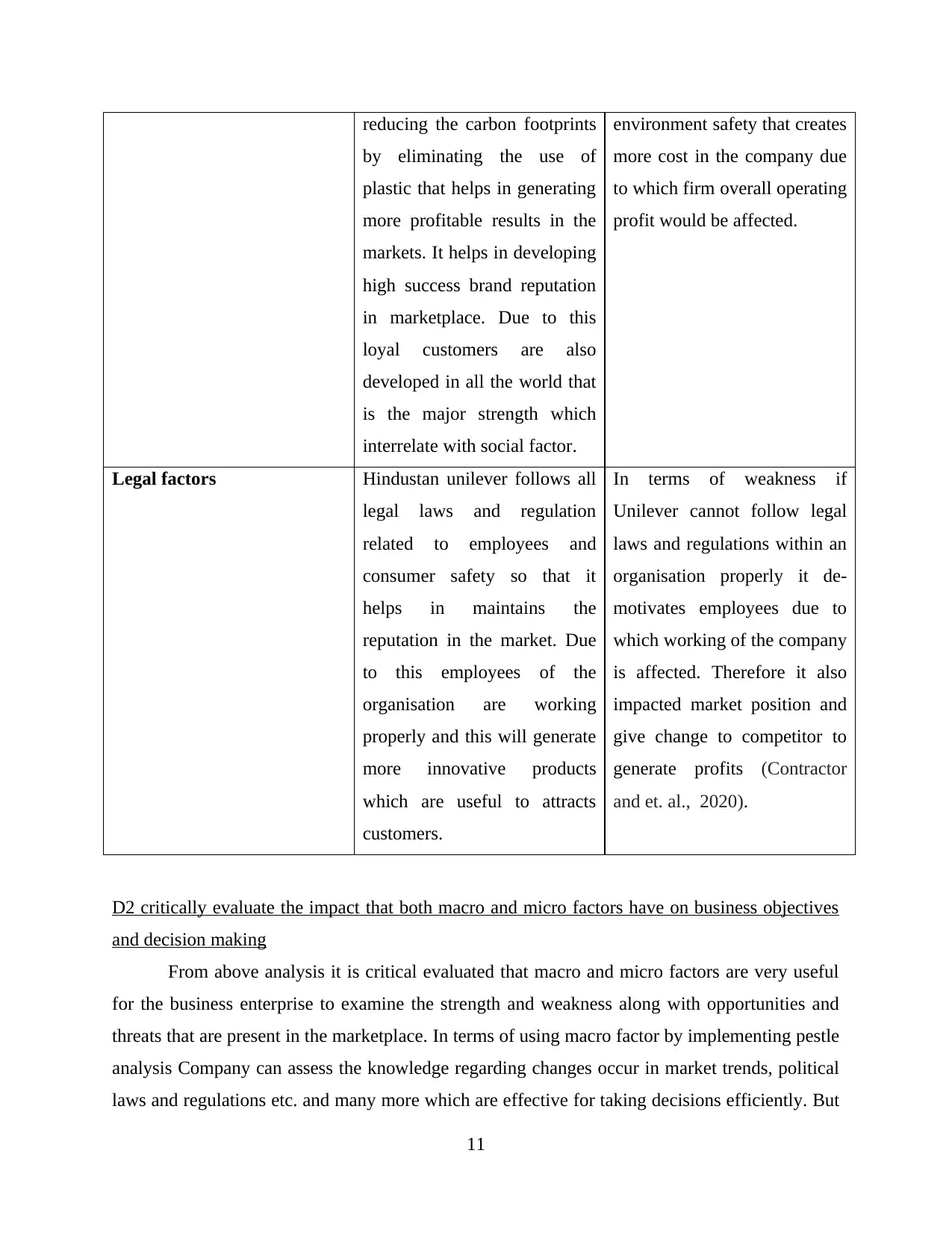
reducing the carbon footprints
by eliminating the use of
plastic that helps in generating
more profitable results in the
markets. It helps in developing
high success brand reputation
in marketplace. Due to this
loyal customers are also
developed in all the world that
is the major strength which
interrelate with social factor.
environment safety that creates
more cost in the company due
to which firm overall operating
profit would be affected.
Legal factors Hindustan unilever follows all
legal laws and regulation
related to employees and
consumer safety so that it
helps in maintains the
reputation in the market. Due
to this employees of the
organisation are working
properly and this will generate
more innovative products
which are useful to attracts
customers.
In terms of weakness if
Unilever cannot follow legal
laws and regulations within an
organisation properly it de-
motivates employees due to
which working of the company
is affected. Therefore it also
impacted market position and
give change to competitor to
generate profits (Contractor
and et. al., 2020).
D2 critically evaluate the impact that both macro and micro factors have on business objectives
and decision making
From above analysis it is critical evaluated that macro and micro factors are very useful
for the business enterprise to examine the strength and weakness along with opportunities and
threats that are present in the marketplace. In terms of using macro factor by implementing pestle
analysis Company can assess the knowledge regarding changes occur in market trends, political
laws and regulations etc. and many more which are effective for taking decisions efficiently. But
11
by eliminating the use of
plastic that helps in generating
more profitable results in the
markets. It helps in developing
high success brand reputation
in marketplace. Due to this
loyal customers are also
developed in all the world that
is the major strength which
interrelate with social factor.
environment safety that creates
more cost in the company due
to which firm overall operating
profit would be affected.
Legal factors Hindustan unilever follows all
legal laws and regulation
related to employees and
consumer safety so that it
helps in maintains the
reputation in the market. Due
to this employees of the
organisation are working
properly and this will generate
more innovative products
which are useful to attracts
customers.
In terms of weakness if
Unilever cannot follow legal
laws and regulations within an
organisation properly it de-
motivates employees due to
which working of the company
is affected. Therefore it also
impacted market position and
give change to competitor to
generate profits (Contractor
and et. al., 2020).
D2 critically evaluate the impact that both macro and micro factors have on business objectives
and decision making
From above analysis it is critical evaluated that macro and micro factors are very useful
for the business enterprise to examine the strength and weakness along with opportunities and
threats that are present in the marketplace. In terms of using macro factor by implementing pestle
analysis Company can assess the knowledge regarding changes occur in market trends, political
laws and regulations etc. and many more which are effective for taking decisions efficiently. But
11
Paraphrase This Document
Need a fresh take? Get an instant paraphrase of this document with our AI Paraphraser
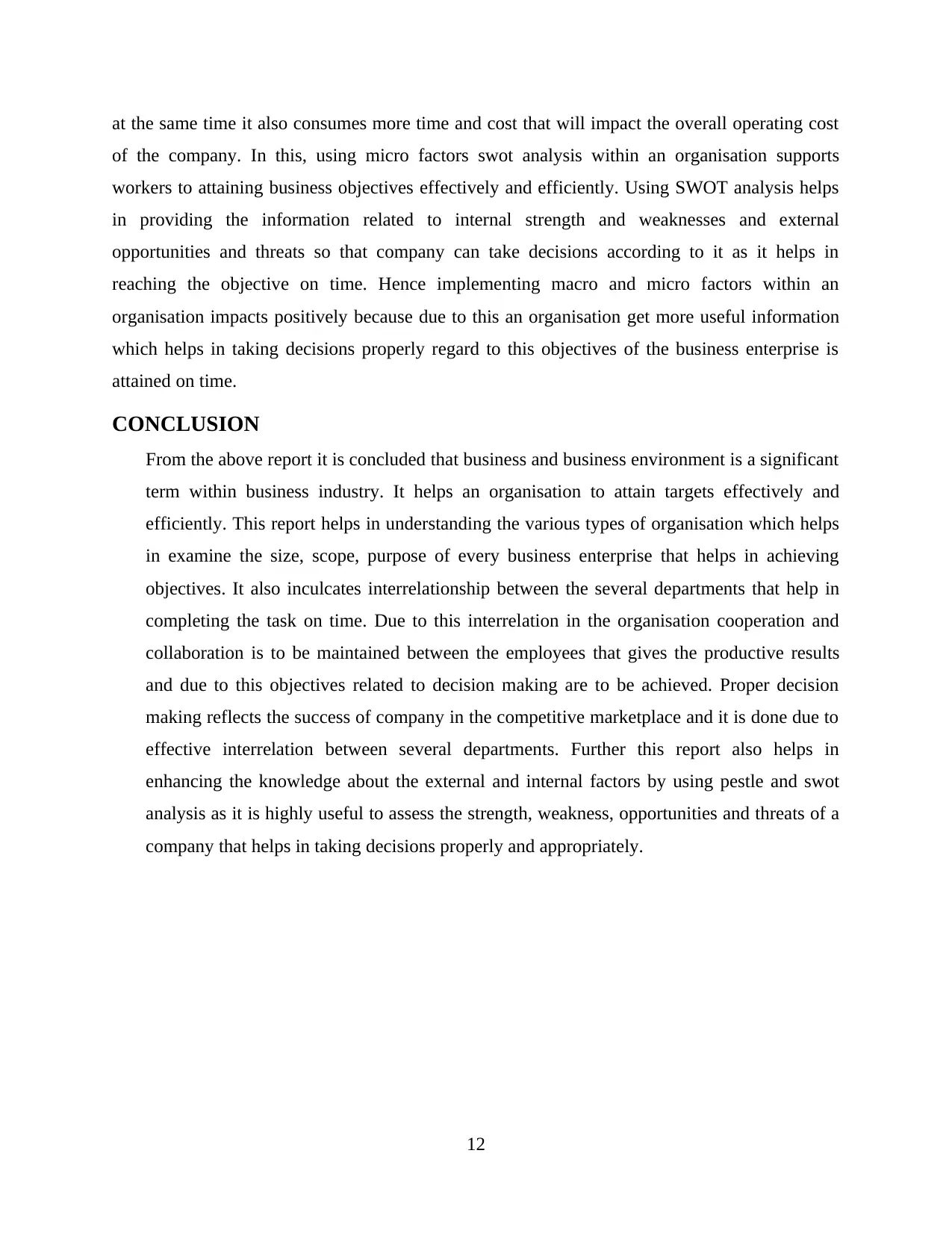
at the same time it also consumes more time and cost that will impact the overall operating cost
of the company. In this, using micro factors swot analysis within an organisation supports
workers to attaining business objectives effectively and efficiently. Using SWOT analysis helps
in providing the information related to internal strength and weaknesses and external
opportunities and threats so that company can take decisions according to it as it helps in
reaching the objective on time. Hence implementing macro and micro factors within an
organisation impacts positively because due to this an organisation get more useful information
which helps in taking decisions properly regard to this objectives of the business enterprise is
attained on time.
CONCLUSION
From the above report it is concluded that business and business environment is a significant
term within business industry. It helps an organisation to attain targets effectively and
efficiently. This report helps in understanding the various types of organisation which helps
in examine the size, scope, purpose of every business enterprise that helps in achieving
objectives. It also inculcates interrelationship between the several departments that help in
completing the task on time. Due to this interrelation in the organisation cooperation and
collaboration is to be maintained between the employees that gives the productive results
and due to this objectives related to decision making are to be achieved. Proper decision
making reflects the success of company in the competitive marketplace and it is done due to
effective interrelation between several departments. Further this report also helps in
enhancing the knowledge about the external and internal factors by using pestle and swot
analysis as it is highly useful to assess the strength, weakness, opportunities and threats of a
company that helps in taking decisions properly and appropriately.
12
of the company. In this, using micro factors swot analysis within an organisation supports
workers to attaining business objectives effectively and efficiently. Using SWOT analysis helps
in providing the information related to internal strength and weaknesses and external
opportunities and threats so that company can take decisions according to it as it helps in
reaching the objective on time. Hence implementing macro and micro factors within an
organisation impacts positively because due to this an organisation get more useful information
which helps in taking decisions properly regard to this objectives of the business enterprise is
attained on time.
CONCLUSION
From the above report it is concluded that business and business environment is a significant
term within business industry. It helps an organisation to attain targets effectively and
efficiently. This report helps in understanding the various types of organisation which helps
in examine the size, scope, purpose of every business enterprise that helps in achieving
objectives. It also inculcates interrelationship between the several departments that help in
completing the task on time. Due to this interrelation in the organisation cooperation and
collaboration is to be maintained between the employees that gives the productive results
and due to this objectives related to decision making are to be achieved. Proper decision
making reflects the success of company in the competitive marketplace and it is done due to
effective interrelation between several departments. Further this report also helps in
enhancing the knowledge about the external and internal factors by using pestle and swot
analysis as it is highly useful to assess the strength, weakness, opportunities and threats of a
company that helps in taking decisions properly and appropriately.
12
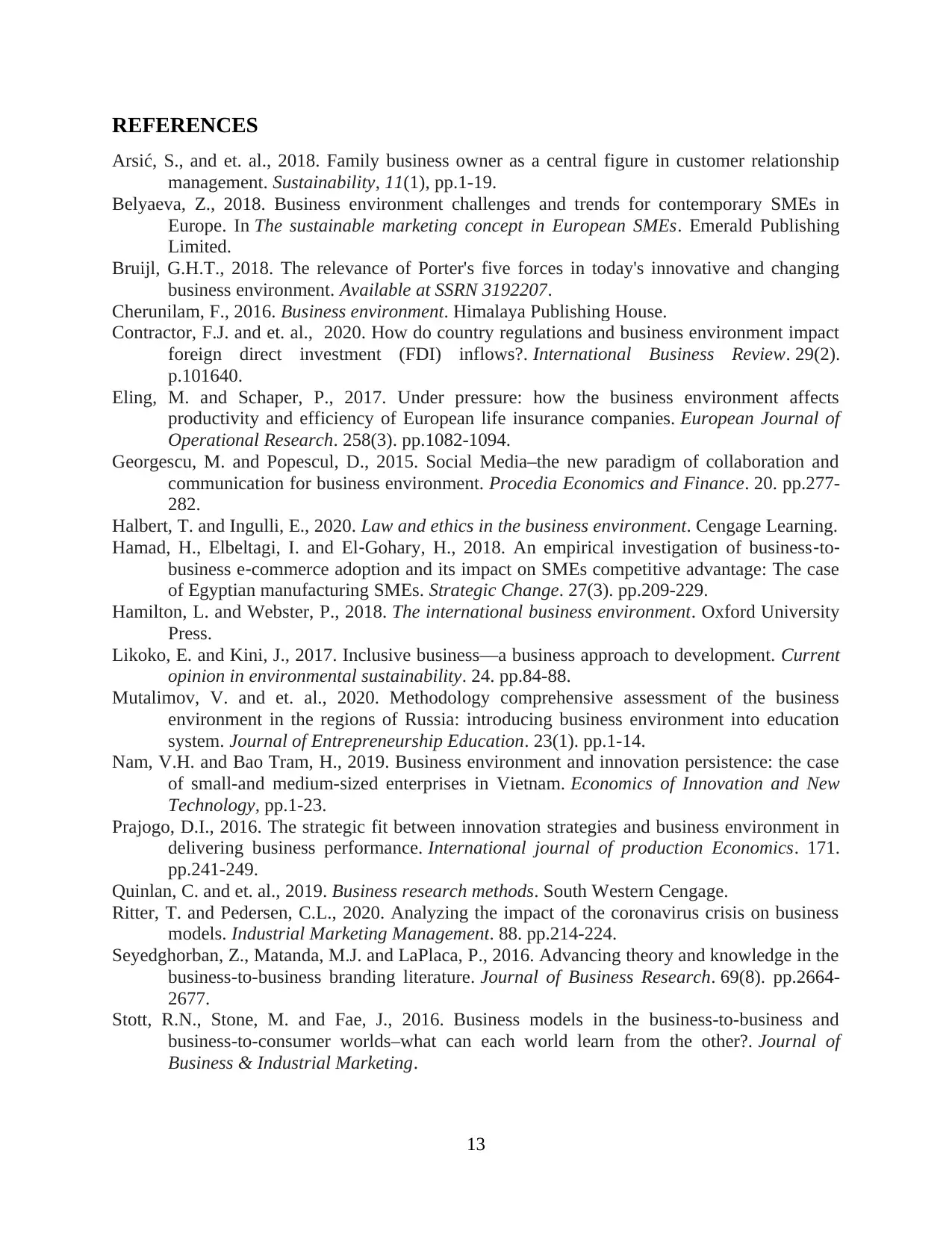
REFERENCES
Arsić, S., and et. al., 2018. Family business owner as a central figure in customer relationship
management. Sustainability, 11(1), pp.1-19.
Belyaeva, Z., 2018. Business environment challenges and trends for contemporary SMEs in
Europe. In The sustainable marketing concept in European SMEs. Emerald Publishing
Limited.
Bruijl, G.H.T., 2018. The relevance of Porter's five forces in today's innovative and changing
business environment. Available at SSRN 3192207.
Cherunilam, F., 2016. Business environment. Himalaya Publishing House.
Contractor, F.J. and et. al., 2020. How do country regulations and business environment impact
foreign direct investment (FDI) inflows?. International Business Review. 29(2).
p.101640.
Eling, M. and Schaper, P., 2017. Under pressure: how the business environment affects
productivity and efficiency of European life insurance companies. European Journal of
Operational Research. 258(3). pp.1082-1094.
Georgescu, M. and Popescul, D., 2015. Social Media–the new paradigm of collaboration and
communication for business environment. Procedia Economics and Finance. 20. pp.277-
282.
Halbert, T. and Ingulli, E., 2020. Law and ethics in the business environment. Cengage Learning.
Hamad, H., Elbeltagi, I. and El‐Gohary, H., 2018. An empirical investigation of business‐to‐
business e‐commerce adoption and its impact on SMEs competitive advantage: The case
of Egyptian manufacturing SMEs. Strategic Change. 27(3). pp.209-229.
Hamilton, L. and Webster, P., 2018. The international business environment. Oxford University
Press.
Likoko, E. and Kini, J., 2017. Inclusive business—a business approach to development. Current
opinion in environmental sustainability. 24. pp.84-88.
Mutalimov, V. and et. al., 2020. Methodology comprehensive assessment of the business
environment in the regions of Russia: introducing business environment into education
system. Journal of Entrepreneurship Education. 23(1). pp.1-14.
Nam, V.H. and Bao Tram, H., 2019. Business environment and innovation persistence: the case
of small-and medium-sized enterprises in Vietnam. Economics of Innovation and New
Technology, pp.1-23.
Prajogo, D.I., 2016. The strategic fit between innovation strategies and business environment in
delivering business performance. International journal of production Economics. 171.
pp.241-249.
Quinlan, C. and et. al., 2019. Business research methods. South Western Cengage.
Ritter, T. and Pedersen, C.L., 2020. Analyzing the impact of the coronavirus crisis on business
models. Industrial Marketing Management. 88. pp.214-224.
Seyedghorban, Z., Matanda, M.J. and LaPlaca, P., 2016. Advancing theory and knowledge in the
business-to-business branding literature. Journal of Business Research. 69(8). pp.2664-
2677.
Stott, R.N., Stone, M. and Fae, J., 2016. Business models in the business-to-business and
business-to-consumer worlds–what can each world learn from the other?. Journal of
Business & Industrial Marketing.
13
Arsić, S., and et. al., 2018. Family business owner as a central figure in customer relationship
management. Sustainability, 11(1), pp.1-19.
Belyaeva, Z., 2018. Business environment challenges and trends for contemporary SMEs in
Europe. In The sustainable marketing concept in European SMEs. Emerald Publishing
Limited.
Bruijl, G.H.T., 2018. The relevance of Porter's five forces in today's innovative and changing
business environment. Available at SSRN 3192207.
Cherunilam, F., 2016. Business environment. Himalaya Publishing House.
Contractor, F.J. and et. al., 2020. How do country regulations and business environment impact
foreign direct investment (FDI) inflows?. International Business Review. 29(2).
p.101640.
Eling, M. and Schaper, P., 2017. Under pressure: how the business environment affects
productivity and efficiency of European life insurance companies. European Journal of
Operational Research. 258(3). pp.1082-1094.
Georgescu, M. and Popescul, D., 2015. Social Media–the new paradigm of collaboration and
communication for business environment. Procedia Economics and Finance. 20. pp.277-
282.
Halbert, T. and Ingulli, E., 2020. Law and ethics in the business environment. Cengage Learning.
Hamad, H., Elbeltagi, I. and El‐Gohary, H., 2018. An empirical investigation of business‐to‐
business e‐commerce adoption and its impact on SMEs competitive advantage: The case
of Egyptian manufacturing SMEs. Strategic Change. 27(3). pp.209-229.
Hamilton, L. and Webster, P., 2018. The international business environment. Oxford University
Press.
Likoko, E. and Kini, J., 2017. Inclusive business—a business approach to development. Current
opinion in environmental sustainability. 24. pp.84-88.
Mutalimov, V. and et. al., 2020. Methodology comprehensive assessment of the business
environment in the regions of Russia: introducing business environment into education
system. Journal of Entrepreneurship Education. 23(1). pp.1-14.
Nam, V.H. and Bao Tram, H., 2019. Business environment and innovation persistence: the case
of small-and medium-sized enterprises in Vietnam. Economics of Innovation and New
Technology, pp.1-23.
Prajogo, D.I., 2016. The strategic fit between innovation strategies and business environment in
delivering business performance. International journal of production Economics. 171.
pp.241-249.
Quinlan, C. and et. al., 2019. Business research methods. South Western Cengage.
Ritter, T. and Pedersen, C.L., 2020. Analyzing the impact of the coronavirus crisis on business
models. Industrial Marketing Management. 88. pp.214-224.
Seyedghorban, Z., Matanda, M.J. and LaPlaca, P., 2016. Advancing theory and knowledge in the
business-to-business branding literature. Journal of Business Research. 69(8). pp.2664-
2677.
Stott, R.N., Stone, M. and Fae, J., 2016. Business models in the business-to-business and
business-to-consumer worlds–what can each world learn from the other?. Journal of
Business & Industrial Marketing.
13
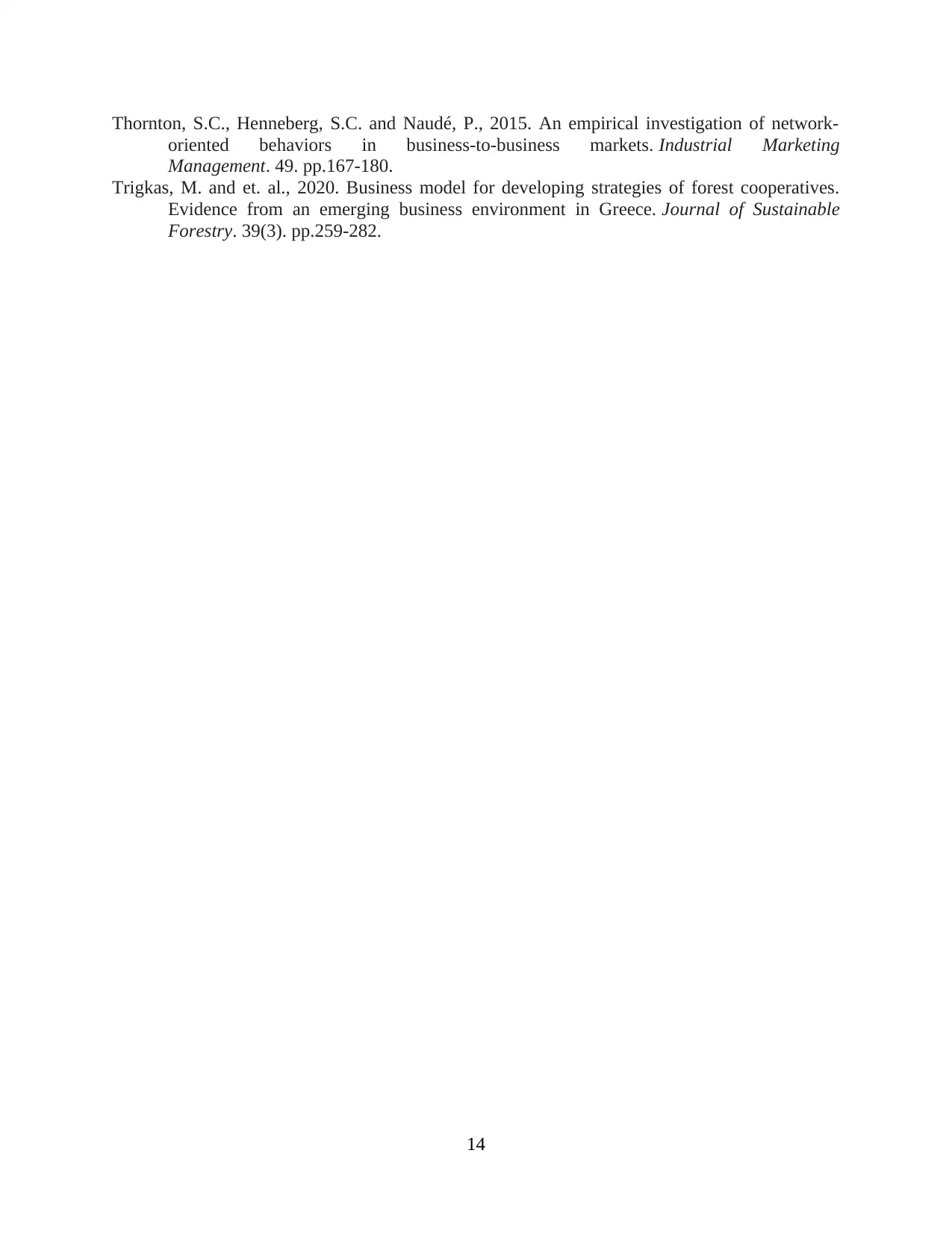
Thornton, S.C., Henneberg, S.C. and Naudé, P., 2015. An empirical investigation of network-
oriented behaviors in business-to-business markets. Industrial Marketing
Management. 49. pp.167-180.
Trigkas, M. and et. al., 2020. Business model for developing strategies of forest cooperatives.
Evidence from an emerging business environment in Greece. Journal of Sustainable
Forestry. 39(3). pp.259-282.
14
oriented behaviors in business-to-business markets. Industrial Marketing
Management. 49. pp.167-180.
Trigkas, M. and et. al., 2020. Business model for developing strategies of forest cooperatives.
Evidence from an emerging business environment in Greece. Journal of Sustainable
Forestry. 39(3). pp.259-282.
14
1 out of 16
Related Documents
Your All-in-One AI-Powered Toolkit for Academic Success.
+13062052269
info@desklib.com
Available 24*7 on WhatsApp / Email
![[object Object]](/_next/static/media/star-bottom.7253800d.svg)
Unlock your academic potential
© 2024 | Zucol Services PVT LTD | All rights reserved.





